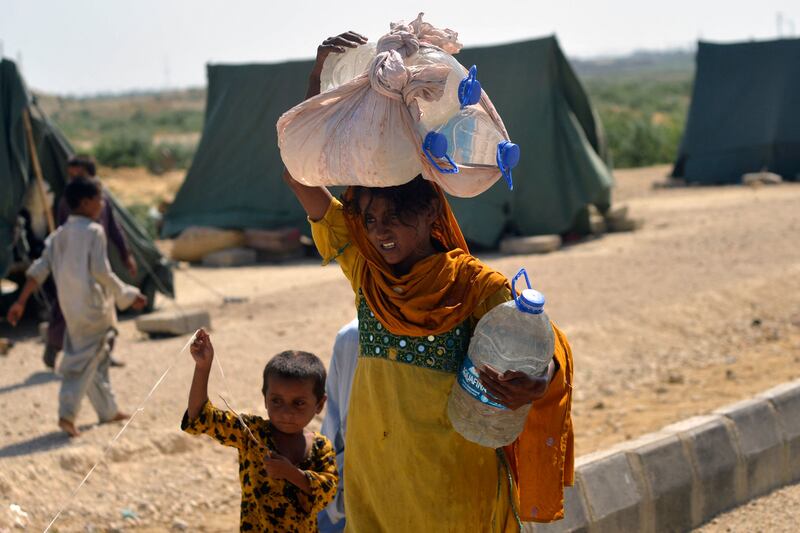Moody's Investors Service downgraded Pakistan's sovereign rating deeper into junk territory and maintained a negative outlook on the country owing to the sharp deterioration of its economy as a result of the effects of recent floods.
The country's local and foreign currency issuer and senior unsecured debt ratings were cut to Caa1 from B3, Moody's said in a statement late on Thursday. Such a rating makes it more difficult to access capital markets and raise financing.
"The decision to downgrade the ratings ... is driven by increased government liquidity and external vulnerability risks and higher debt sustainability risks, in the aftermath of devastating floods that hit the country since June 2022," Moody's said.
"The floods have exacerbated Pakistan's liquidity and external credit weaknesses and vastly increase social spending needs, while government revenue is severely hit. Debt affordability, a long-standing credit weakness for Pakistan, will remain extremely weak for the foreseeable future."
Rising prices globally and delayed policy action by Pakistan's government hit the country’s finances, leading to significant exchange-rate depreciation, a surge in inflation and an erosion of its foreign currency reserves. Torrential rain and flooding that submerged one third of the country and killed more than 1,000 people have piled pressure on its faltering economy.
Before the flooding, a weakening economy forced the government to raise fuel prices by more than 20 per cent this year and the country has struggled to recover from floods. The economic outlook in the near and medium term has deteriorated sharply as a result of the floods. The government's preliminary estimates put the economic cost of the floods at about $30 billion, equivalent to 10 per cent of gross domestic product.
In August, the International Monetary Fund released about $1.1bn to Pakistan as part of its seventh and eighth reviews of the country's bail-out programme, helping it avoid a default crisis similar to Sri Lanka's. The fund also agreed to extend the programme by a year to the end of June 2023 and increase the total amount of funding by about $940 million.
The release of funds brings the total support extended by the Washington-based lender under the programme to about $6.5bn.
The country's IMF loan programme agreed in 2019 had stalled under the government of former prime minister Imran Khan, which backtracked on subsidy agreements and failed to improve tax collection, but Pakistan and the fund resumed a staff-level agreement in July to resume the funding facility.
"Pakistan will remain highly reliant on financing from multilateral partners and other official sector creditors to meet its debt payments, in the absence of access to market financing at affordable costs," Moody's said.
The rating agency said it expects Pakistan's IMF programme will remain in place and help it secure funding from other multilateral and bilateral partners in the near term.
The economic outlook of the country is expected to worsen in the near and medium-term as elevated social and political risks compound the government's difficulty to implement reforms that include revenue-generating measures, that would boost its finances and reduce liquidity stresses, the agency said.
The floods will also raise Pakistan's external financing needs, increasing the risks of a balance of payments crisis and the negative outlook also captures risks that, should a debt restructuring be needed, it may extend to private sector creditors, Moody's said.
The agency projects GDP growth of 0 per cent to 1 per cent for Pakistan's fiscal 2023 year that runs to the end of June 2023. That compares with an earlier forecast before the floods of 3 per cent to 4 per cent.
"The floods will affect all sectors, with the impact likely more acute in the agriculture sector, which makes up about one-quarter of the economy," Moody's said.
Agriculture accounts for about 20 per cent of GDP and exports, and nearly 40 per cent of total employment. About 70 per cent of the entire population live in rural areas.
As the economy recovers from the floods, the agency expects growth to pick up next year but stay below the previous trend.
Inflation in the country that averaged 25 per cent from July to September 2022 is forecast to pick up to 25 per cent to 30 per cent on average for fiscal 2023, Moody's said.
As a result of rising interest rates globally and weaker revenue collection it estimates Pakistan's interest payments will increase to about 50 per cent in fiscal 2023, from 40 per cent of government revenue in fiscal 2022, and stabilise at this level for the next few years.
The current account deficit is expected to widen to 3.5 per cent to 4.5 per cent of GDP for fiscal 2023. The country's foreign exchange reserves, which cover less than two months of imports, limit Pakistan's ability to substantially draw down on them to meet debt or imports payments needs, without risking a balance of payments crisis, the agency said.






